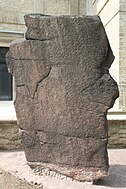Menhir from Krosigk
| Menhir from Krosigk Schön-Ännchenstein, Frößnitzstein, Heidenstein | |||
|---|---|---|---|
|
The menhir of Krosigk at the State Museum for Prehistory in Halle (Saale) |
|||
|
|||
| Coordinates | Krosigk , Halle | ||
| place | originally Petersberg OT Krosigk , now Halle (Saale) , Saxony-Anhalt , Germany | ||
The Menhir von Krosigk (also nice-Ännchenstein , Frößnitzstein or Heidenstein ) is menhir , originally near Krosigk , a district of Petersberg in Saalekreis , Sachsen-Anhalt stood on the east side of today Regional Museum of Prehistory in Halle (Saale) is set up .
description
The menhir is made of rhyolite and has the shape of a flat plate. It has a height of 2.68 m and a thickness of 0.36 m, the width varies between 1.56 m and 1.96 m. The original location of the stone is near the new houses, west of Krosigk in the former Löbejun wood. The name "Frößnitzstein" is derived from the Petersberg district of Frößnitz, which, however, lies south of Krosigk. From the area around the menhir there are finds of the band ceramic culture , the string ceramic , the Bronze Age , the Roman Imperial Age , the Slavic Early Middle Ages and the Middle Ages .
The menhir of Krosigk in regional sagas
Two legends have been handed down about the menhir of Krosigk. According to the First, treasure is said to be buried under the stone. The second explains the name "Schön-Annchenstein" and is located during the Hussite Wars : a noble lady is said to have died in the Gottkau mill. Her daughter Anna was then raised by the millers. Later she became a playmate of the son of the lord of the castle von Löbejün . In 1429 there was a Hussite attack in which the lord of the castle was killed and Anna was taken prisoner. When this Procop , the leader of the Hussites, called for help, she too was killed. Procop then arranged a princely funeral. The menhir should mark the place of her grave.
Replica
A scaled-down replica of the menhir has been located near the original location near Krosigk since 2003. This has a height of 1.85 m including the base.
literature
- Paul Grimm : Of upright stones (menhirs) in Central Germany. In: Mitteldeutsche Volkheit. Volume 3, 1936, pp. 69-70.
- Johannes Groht : Menhirs in Germany. State Office for Monument Preservation and Archeology Saxony-Anhalt, Halle (Saale) 2013, ISBN 978-3-943904-18-5 , pp. 455–456.
- Christian Keferstein : Views on the Celtic antiquities, the Celts in general and especially in Germany, as well as the Celtic origin of the city of Halle. 1st volume: Archaeological content. Halle 1846, pp. 13-14 ( online ).
- Horst Kirchner : The menhirs in Central Europe and the menhir thought (= Academy of Sciences and Literature. Treatises of the humanities and social sciences class. Born 1955, No. 9). Wiesbaden 1955, pp. 181-182.
- Waldemar Matthias : The open-air facilities at the State Museum for Prehistory Halle (Saale). In: Annual journal for Central German Prehistory. Volume 67, 1984, pp. 197-203 ( online ).
- Waldtraut Schrickel : Western European elements in the Neolithic and the Early Bronze Age of Central Germany. Part I. Catalog. Publications of the State Museum for Prehistory Dresden, Volume 5, VEB Bibliographisches Institut, Leipzig 1957, pp. 46–47.
- Siegmar von Schultze-Galléra : Nice Ännchen von Gottgau. Hall 1914.
- Siegmar von Schultze-Galléra: Walks through the Saalkreis. Volume 3, Hall 1920.
- Britta Schulze-Thulin : Large stone graves and menhirs. Saxony-Anhalt • Thuringia • Saxony . Mitteldeutscher Verlag, Halle (Saale) 2007, ISBN 978-3-89812-428-7 , p. 87.
Web links
- The Megalithic Portal: Menhir von Krosigk , Menhirdenkmal Krosigk
- strahlen.org: Converted menhir from Krosigk ("Schön-Ännchenstein"), in Halle
- grosssteingraeber.de: The menhir from Krosigk
- halle-im-bild.de: Schön-Ännchen-Stein
- cruptorix.nl: Krosigk, Schön-Ännchenstein

